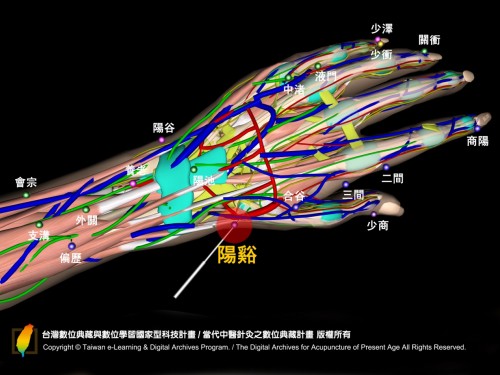TELDAP Collections
| The Art of Acupuncture — The Digital Archives of Contemporary Chinese Acupuncture |
|
By Yang Yuling This article is provided by the Call for Entries Campaign of the Taiwan Digital Archives Expansion Project under the Taiwan e-Learning & Digital Archives Program (TELDAP)
A detailed acupuncture-point chart on the Digital Archives of Contemporary Chinese Acupuncture website
"Hold your breath, concentrate, observe closely, and press the needle into the exact point." For thousands’ of years, traditional Chinese medicine has been hidden behind a mysterious veil. Now the ancient practices are being revitalized with the help of modern scientific research. Fascinated by Chinese medicine’s long history and contemporary empirical evidence supporting it, professor Chen Qingwen began digitizing the Chinese acupuncture system seven years ago. "We are the beneficiaries of Chinese culture. We have to protect our ancestors’ wisdom, no matter what it takes." Chen said. Currently a professor of computer science and multimedia design at Taiwan Shoufu University (formerly known as the Diwan College of Management), Chen is the leader of the Digital Archives of Contemporary Chinese Acupuncture project. Chen is well-read in the Chinese literary classics, and has practiced martial arts for more than a decade. Seven years ago, his academic path took a dramatic turn when he came across traditional Chinese medicine by chance.
Foundational materials for modern teaching in the field of Chinese medicine are usually texts dating back to the Ming Dynasty (AD 1368-1644). The 14-meridian theory, for instance, is covered in these classic books. But, the modern field has expanded, and after nearly a century of reform and innovation, traditional Chinese medicine has flourished with the development of different treatments, such as acupuncture on the head and ear areas. Such achievements, however, have never been systematically organized, so professor Chen decided to build a digital acupuncture system.
A teacher of information technology himself, Chen has incorporated his expertise into the project. Besides collecting traditional texts from different schools of thought, his team has also constructed a digital platform where acupuncture points (also called acupoints) are mapped in three dimensions. These 3D models of muscles, bones, and blood vessels can help users understand the location and function of each point. These images can be viewed from different angles on demand. To illustrate the procedure, the database provides videos of actual acupuncture application. In comparison to conventional teaching aids such as a copper man or pictures in a book, this system explains the locations of acupoints in a vivid and precise way. Everyone, from traditional Chinese medicine practitioners and medical students to laymen, can accurately locate a point with the help of the database. To further assist doctors in diagnosis, Chen’s team has also developed a prescription exploration system and an assessment and treatment system. When a patient's symptoms are entered into the two systems, possible causes and suggested acupoints for treatment are immediately displayed. The systems improve accuracy and reduce the time needed for diagnosis.
3D picture: acupuncture points, bones, and muscles
In the database, Chen has included the studies of the four traditional Chinese medicine masters — Dong Jingchang, Sun Peirong, Xiu Yangzhai, and Wang Yunan — by archiving their writings on acupuncture, as well as pictures and case studies. To make use of knowledge from different schools of thought, a user only needs to enter symptoms into the system to search for the relevant literature. Such a rich collection reminds us of earlier practitioners’ hard work. The system has collected 73 traditional texts, covering acupuncture techniques on the ear, head, and hand areas. Despite gathering a large and high-quality collection in such a short period of time, Chen said, "the field of traditional Chinese medicine is so broad and deep. We have to complete the 3D items and the virtual reality system before we think about adding other features, such as data for free download."
Aside from improving the teaching and practice of Chinese medicine, Chen hopes that in the long run the database will help educate the public about acupuncture and its practical uses in daily life. He did not establish the system to be an authority on Chinese medicine. After all, it takes years of education and hard work to become a physician, and for thousands of years, Chinese medicine has been most frequently taught through apprenticeship. This database, then, serves as a diagnostic aid, which provides valuable information to users with different needs. For the past few years, Chen has been promoting the use of the system and teaching the public about acupressure (pressing acupuncture points without using needles) as a preventive health measure. In the process, Chen noticed that an increasing number of people have become interested in Chinese medicine and some have started to study it. One particular anecdote is his most memorable example, when an old student came back to to ask him for help. After learning about acupressure from Chen via the 3D system, the student went home and applied the techniques to his father, who had suffered a stroke. His father, who was paralyzed in bed, felt immediate results from the acupressure. Since nonprofessionals cannot administer acupuncture, acupressure is a good option for at-home disease prevention. Digitization makes traditional Chinese medicine more accessible, Chen said, adding that his archival project is almost complete.
The professor reflected on the countless difficulties he encountered and how he overcame each with a bit of luck. Perhaps, he said, he was fated to accomplish such a mission, and perhaps his team’s blessings came from their selfless devotion to good deeds!
|













